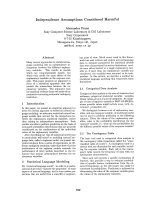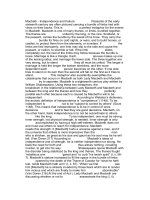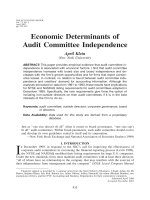Argentinian independence
Bạn đang xem bản rút gọn của tài liệu. Xem và tải ngay bản đầy đủ của tài liệu tại đây (106.66 KB, 2 trang )
Argentinian Independence
When General San Martín’s troops won definitive over the Spanish army, the Argentine Independence begun. Learn more about the
independence of Argentina.
In the beginning of the 16thcentury, long before Argentinian independence, the Spanish arrived to
Argentinian territory, where they were met with an indigenous population of around 330,000 inhabitants that
belonged to different ethnic groups, many of them influenced by the Incan Empire.
After the arrival of Columbus and the conquest, the American territory was divided into two viceroyalties that
directly represented the Spanish king: The Viceroyalty of New Spain (which included the Spanish colonies of
North and South America, Venezuela and the Philipines) and the viceroyalty of Peru (which included all of
South America from Panama to Patagonia, with the exception of Venezuela and Brazil, as Brazil belonged to
the Portuguese crown). The capital of this viceroyalty was in Lima.
Due to the ranching industry and also the importance of the port that the estuary of the Río de la Plata offered,
this region acquired great value and autonomy. In 1776, motivated by the economic importance and by trade
within the Provinces of the Río de la Plata, and also by Brazilian, French and British attempts to seize control
of the area at that time, Carlos III created the Viceroyalty of the Río de la Plata, with its capital in Buenos
Aires. This Viceroyalty included the countries we know today as Argentina, Uruguay, Paraguay, Bolivia and
part of Brazil. The last viceroy, Cisneros, renounced his post before the angry crowd gathered at the open
cabildo (meeting of local leaders) in Buenos Aires on May 25, 1810.
The May Revolution
In 1810, tensions between creoles (Spaniards born in the Americas) and peninsulars (newly arrived Spaniards
in the Americas) for control of the region's trade increased. A series of revolutionary groups found an excuse
in the capture of the Spanish king Fernando VII, and the French occupation of Spain during the Peninsular
War, to call an open cabildo with the hopes of discussing the political situation.
May 22, 23 and 24 were days of great agitation: many wanted to depose Viceroy Cisneros from his post, while
others proposed the creation of a junta in which the Viceroy, along with Buenos Aires residents, would play an
active role. When it was decided that the Viceroy would stay, widespread disappointment inspired crowds to
pound at the gates of the open cabildo and shout “the people want to know what this is all about”; they hoped
for the Viceroy's resignation and the junta's dissolution. This finally happened and the First National
Government Independent of Spain was formed. On July 9, 1816, the independence of the United Provinces of
the Río de la Plata was declared (which included modern-day Argentina, Uruguay and part of Bolivia) in a
meeting of congress in Tucumán. Independence was put into effect in 1817, when General San Martín's troops
won definitive victory over the Spanish army. The Argentine War of Independence, which had begun in
1810, would end the following year in 1818. Viceroyalties continued to exist in Paraguay and in Upper Peru,
causing constant confrontations between royalists (loyalists to the Spanish King) and revolutionaries.
Heroes of Argentinian Independence
Manuel Belrano
On June 20, 1820, Manual Belgrano died in Buenos Aires in complete poverty. Although he had been a
decisive figure in the independence process, and he had spent all his capital on the revolution, only one local
periodical covered the news of his death.
Years later, in 1938, it was decided that the anniversary of his death would be celebrated on Flag Day, since
Belgrano was the first to fly the Argentine flag, an event that took place in the town of Rosario in 1812.
Manuel Belgrano was a firm ideologist of the May Revolution. He defended the city of Buenos Aires from
British attacks in 1806 and 1807 and he became a General to the troops that achieved the Argentine
declaration of independence under the command of General San Martín. He also promoted trade, culture,
rights and education in Argentina.
José San Martín
Martín was an Argentine military leader whose campaigns were decisive in gaining Chilean, Peruvian and
Argentinian independence. Along with Simón Bolívar, he is considered one of the most important liberators of
Spanish colonization in South America. He was born in Argentina, in Yapeyú (in the province of Corrientes)
and between the ages of five to thirty four years of age, he lived in Spain, where he began his military career
actively fighting against Napoleon's troops, for which he was decorated and promoted to the rank of lieutenant
colonel. At that time, he contacted revolutionary groups hoping for American independence and in 1812 he
headed for Buenos Aires to collaborate in the emancipation of the Americas.
After the battle of San Lorenzo, he was placed in charge of the Army of the North, which was always under
heavy attack from Lima royalists. San Martín designed a plan for liberation by attacking Lima by sea. First
having to cross the Andes Mountains, the plan helped defeat royalists in Chile earning Chileans their
independence. Later, he moved toward Lima, where with the support of local armies, he successfully ousted
the viceroy and achieved independence for Peru.
San Martín is not only an important figure in the history of Argentinian independence, but also in that of the
independence of the entire Cono sur. On August 17th, Argentines celebrate The Passage of Immortality of San
Martín, commemorating the day of his death. A monumental mausoleum holds the remains of General San
Martín in the Cathedral of Buenos Aires.









